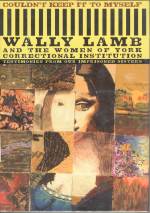
"The brave writers whose work is represented in this volume have acted in good faith, faced their demons, stayed the course, and revised relentlessly. And in taking on the subject of themselves—making themselves vulnerable to the unseen reader—they have exchanged powerlessness for the power that comes with self-awareness."--Wally Lamb
These powerful stories, testaments, hit us on all levels: we can't escape the power of their story, Let's reflect on anything and everything that comes to us as a result of reading them, INCLUDING the art of writing them.
- - 1. Wally Lamb begins his introduction explaining what goes on in editing, quoting different authors on the art of writing, and lists several techniques the authors in this book may have used. Are you familiar with any of these Writing Techniques? Let's keep an eye out for particularly good examples of the writer's craft.
- - How does the beginning of each of first three stories engage the reader immediately?
- - Whose point of view is the story "The True Face of Earth" told from? What effect does this have on the reader?
- - How does this viewpoint increase the poignancy of the story?
- - "Couldn't Keep it to Ourselves:" (page 3)
But authors on tour are quieter, more solitary souls. Between appointments, we sit by ourselves in our rooms, nibbling like prairie dogs on room service sandwiches, or ironing our clothes for the next reading, or watching Judge Judy, ….And sitting on the edge of the bed in room 417 of the Westin Hotel, I uttered in a sheepish voice [while watching Jeopardy! "Who is Wally Lamb?"
- - What a dear man. Does this revelation of what it's really like to be a famous sought after author on tour surprise you?
- - What was your own conception of what being a celebrated author must be like?
"The True Face of Earth:"
- - 3. What does the title "The True Face of Earth" mean?
- - 4."Well, Peanut, always look people right in the eye," Dad advised. "that's what you do in the business world. And if they happen to have a glass eye or some other defect, then look at the bridge of their nose instead. They'll never know the difference." (Page 22). In "The True Face of Earth" the author has very cleverly continued the themes of looking people in the eye throughout the story.
- - How many instances can you find where people did or did not look each other in the eye and what did each reveal about the situation?
- - 5. What other themes do YOU see in this first piece?
- - loneliness (Denjer)
- - emptiness
- - betrayal
- - disillusionment
- - eye contact
- - trust (Zinnia)
Recurring Images/References
- - the egg
- - The airplane/ airport
- - The Little Prince
- - What is the point of view of the author of the piece?
- - How would you describe the tone?
- - What do the references to the airport mean?
- - 7. Saint-Exupery's fable The Little Prince is referred to several times in the piece. Have you read it and does it apply somehow to the story as a whole? What is it about?
- - Have you noticed that "The True Face of Earth" begins and ends with references to Saint-Exupery?
- - In how many ways do the references reflect the narrator and theme of the story?
- - Could you have written this story if even a part of it was yours?
- - Have you ever taken a writing class?
- - What did you write, fiction, non fiction, humor, memoir?
- - If we had, as an exercise at the end of this reading, a short writing effort from everybody on their own lives, could you do it?
- - What must it have taken to rewrite and revisit these events of the past?
What would you think would be the effect on the author?
- - 9. "When I was twelve, Janet went off to college in Massachusetts…" (page 42). This follows the searing tale of the birth of a baby. How old was the author when this birth occurred?
- - 10. Wally Lamb refers to these stories as memoir (page xii.)
- - Memoir is the hottest new genre in literature but what precisely IS a memoir? How does it differ from autobiography, if it does?
- - Wally Lamb mentions the technique of "how to recast memories as dramatic scenes with the help of fictional techniques." Are there any examples of what might be considered "fictional techniques" in this story?
- - 11. What questions would you like to ask of the group or each author if you could ask some? We will get up separate pages for each author.
- - 12. Diane Middlebrook who taught literature and women's studies at Stanford for years suggested that the difference between autobiography and memoir is that a memoir takes place in and pays attention to some sort of historical/cultural context and so speaks to more than an individual experience. She was introducing Tobias Wolff's memoir In Pharoah's Army, a story of Wolff's time in Vietnam. And the definition seemed to fit well there. I wonder, however, if/how it might apply to Nancy Whiteley's stories. The culture of abuse, maybe? Or disfunctional families? I'd be interested in what you all think of this definition of memoir.--Georgia
- - 13. Is the ending optimistic?
Link to questions for the stories. Click HERE!
|





